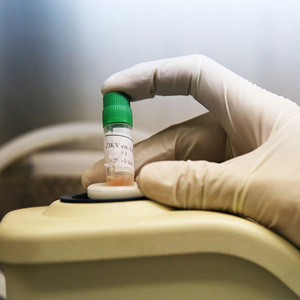
 When the first case of Zika virus disease was diagnosed in Brazil in May, 2015, "The Americas had the unfortunate distinction of being a testing ground for Zika Virus infections" and the disease then became "the new villain in this region, causing fear, economic losses, and most importantly, marking the lives of children and families affected by debilitating birth defects," according to Pan American Health Organization Director Carissa F. Etienne.
When the first case of Zika virus disease was diagnosed in Brazil in May, 2015, "The Americas had the unfortunate distinction of being a testing ground for Zika Virus infections" and the disease then became "the new villain in this region, causing fear, economic losses, and most importantly, marking the lives of children and families affected by debilitating birth defects," according to Pan American Health Organization Director Carissa F. Etienne.
Washington, DC, June 23 2017 (PAHO/WHO) - When the first case of Zika virus disease was diagnosed in Brazil in May, 2015, "The Americas had the unfortunate distinction of being a testing ground for Zika Virus infections" and the disease then became "the new villain in this region, causing fear, economic losses, and most importantly, marking the lives of children and families affected by debilitating birth defects," according to Pan American Health Organization Director Carissa F. Etienne.
In a new perspective piece for the American Journal of Tropical Medicine and Hygiene, "Zika Virus Disease in the Americas: A Storm in the Making," Etienne details PAHO's quick response to Zika and warns, "Future epidemic waves of Zika Virus, which will put additional people at risk, remain likely."
Noting that "More than 700,000 cases of Zika virus disease have been officially reported to the Pan American Health Organization (PAHO) from 48 countries and territories of the Americas," Etienne and co-authors Marcos A. Espinal and Thais dos Santos add that Zika tested public health capacities under the International Health Regulations, "highlighting the need for continued investment in health security" and the pressing need for innovative solutions to persistent problems.
With some 500 million persons in Latin America and the Caribbean living in areas at risk for transmission of Zika, "The fight against Zika virus is not a 100-m race, but rather a marathon in which science and public health need to work hand in hand for the benefit of our peoples," Etienne said.
"Astute front-line health-care workers who first realized that they were detecting something unusual" in clusters of rash illness in Northeast Brazil, increases in neurological disorders like Guillain-Barre syndrome, and then increased numbers of cases of microcephaly are credited by Etienne with sounding the alert on the spread of this formerly obscure virus.
"The Zika virus experience proves once again that good clinical judgment and awareness of atypical events are crucial for the timely detection of emerging and reemerging diseases. It also points to the importance of investing in the health workforce as the first line of defense against infectious disease threats," Etienne said.
Circulation of Zika in the Americas was hard to diagnose because of similarities to dengue and yellow fever, and a backdrop of immunity to other flaviviruses, she noted. "The available defenses against the mosquito responsible for the transmission of these viruses are no longer sufficient to resist its aggressive spread. Therefore, the development of affordable new tools by the scientific community, including diagnostic tests and a vaccine against ZIKAV, as well as innovation in vector control, are urgent priorities. Our health systems will need to be prepared to ensure such new tools are introduced and that their benefits reach everyone, not merely a few," Etienne added.
Etienne outlined PAHO's response, which coordinated more than 80 expert missions to 30 countries bringing in neurologists, neonatologists, obstetricians, epidemiologists, virologists, and specialists in research and health services organization. Training and activities covered clinical management, laboratory diagnosis, risk communication, and vector control. A regional Research Agenda identified current gaps in knowledge to accelerate ways to mitigate the impact of the virus, she said.
Links



